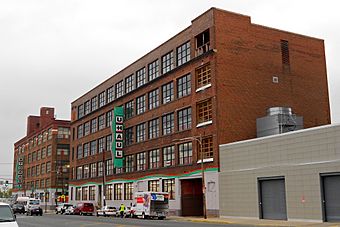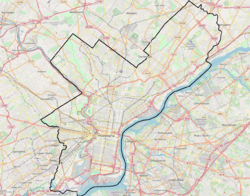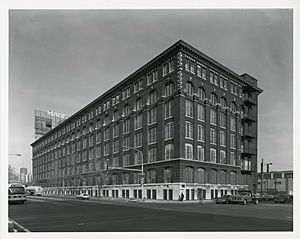Washington Avenue Historic District (Philadelphia) facts for kids
Quick facts for kids |
|
|
Washington Avenue Historic District (Washington Avenue Factory District)
|
|

1135 and 1201 Washington
|
|
| Location | Roughly bounded by Carpenter, Washington, 10th, and Broad Sts., Philadelphia, Pennsylvania |
|---|---|
| Area | 16 acres (6.5 ha) |
| Built | 1889 |
| Architect | Multiple |
| NRHP reference No. | 84003561 |
| Added to NRHP | September 7, 1984 |
| Location | Philadelphia |
|---|---|
| West end | Grays Ferry Avenue in South Philadelphia |
| Major junctions |
Front Street in South Philadelphia |
| East end | Columbus Boulevard in South Philadelphia |
The Washington Avenue Historic District is a special area in South Philadelphia, Pennsylvania. It is also known as the Washington Avenue Factory District. This district is a "historic district," which means it's a place with important old buildings. These buildings show us what life and work were like in the past.
This district is located in the Hawthorne and Bella Vista neighborhoods. It includes four blocks that were once a big industrial area in Philadelphia. Eight important buildings, built between 1889 and 1927, are part of this district:
- 1001 Washington Avenue: C. J. Milne Factory
- 1101 Washington Avenue: Curtis Publishing Company
- 1135 Washington Avenue: American Cigar Company
- 1201 Washington Avenue: John Wyeth Chemical Works
- 1301 Washington Avenue: National Licorice Company
- 1001 S. Broad Street: John Wanamaker Clothing Factory
- 1200 Carpenter Street: John Williams and Company
- 1217-37 Carpenter Street: Main Belting Company
The Washington Avenue Historic District was added to the National Register of Historic Places in 1984. This means it is officially recognized as a place worth protecting because of its history.
Contents
A Look Back: Washington Avenue's Factory Past
Washington Avenue was once a very busy area filled with factories and manufacturing plants. People even called it the "workshop of the world" until the mid-1900s. This nickname shows how many things were made there!
How Factories Came to Washington Avenue
Before the factories, some parts of Washington Avenue looked very different. In 1875, where the Milne Factory stands now, there was a cemetery. The site of the Curtis Building was a lumberyard. The Wyeth sites were coal yards.
Industry started to grow on Washington Avenue because of the Philadelphia, Wilmington and Baltimore Railroad. Train tracks ran right through the middle of Washington Avenue. This made it easy to connect factories to each other and to the rest of the country.
The first big factory to arrive was John Wyeth's chemical and medicine company in 1889. They built several buildings near the train tracks. One of these was a large five-story building built in 1909.
In 1890, John Wanamaker built a warehouse to store his goods. Ten years later, he built a huge six-story factory at Broad and Washington.
Caleb Milne built an even bigger factory in 1895. It was 376 feet long and stretched between 10th and 11th Streets.
By 1900, the John Williams Cotton and Woolen Mill was making cloth. It expanded its building in 1906. The Main Belting Company also grew, adding to its building in 1902 and 1911.
The Curtis Publishing Company Warehouse and the American Cigar Company were also on Washington Avenue. The National Licorice Company built its modern factory in 1927-28. This completed the group of important industrial buildings in the area.
What Was Made Here?
These large factory buildings were very important to the community. They provided jobs for thousands of workers. People worked to weave cloth for John Williams and C.J. Milne. Others sewed clothes for John Wanamaker.
Workers also handled supplies for Curtis Publishing, which printed famous magazines like Ladies' Home Journal and The Saturday Evening Post. Some wrapped cigars for American Cigars. Others made medicines at John Wyeth Laboratories or candy for National Licorice.
Many of these buildings also have interesting designs. For example, the Milne factory used a new type of roof support called the "Superspan Truss." This design influenced how many other factories were built.
Images for kids
Getting Around: Public Transportation
You can reach the Washington Avenue Historic District using SEPTA's Route 64 bus. Many other bus routes also cross Washington Avenue. The Broad Street Line subway also has a station nearby at Ellsworth-Federal.









